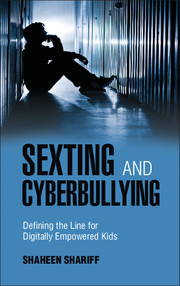Book contents
- Frontmatter
- Dedication
- Contents
- Preface
- Acknowledgments
- Chapter One Confronting Cyberbullying
- Chapter Two Sexism Defines the Lines between Fun and Power
- Chapter Three The Irony of Charging Children with Distribution of Child Pornography
- Chapter Four Keeping Kids Out of Court: Jokes, Defamation, and Duty to Protect
- Chapter Five From Lord of the Flies to Harry Potter: Freedom, Choices, and Guilt
- Appendix A Charting Out Canadian and U.S. Anti-Bullying Legislation (as it Applies or Can be Applied to Cyberbullying Incidents)
- Appendix B Expanded DTL Research Data
- Appendix C Sample Workshop Provided to Undergraduate Students at McGill University
- Appendix D Public Policy, Law, and Digital Media (Sample University-Level Course)
- Index
- References
Chapter Four - Keeping Kids Out of Court: Jokes, Defamation, and Duty to Protect
Published online by Cambridge University Press: 18 December 2014
- Frontmatter
- Dedication
- Contents
- Preface
- Acknowledgments
- Chapter One Confronting Cyberbullying
- Chapter Two Sexism Defines the Lines between Fun and Power
- Chapter Three The Irony of Charging Children with Distribution of Child Pornography
- Chapter Four Keeping Kids Out of Court: Jokes, Defamation, and Duty to Protect
- Chapter Five From Lord of the Flies to Harry Potter: Freedom, Choices, and Guilt
- Appendix A Charting Out Canadian and U.S. Anti-Bullying Legislation (as it Applies or Can be Applied to Cyberbullying Incidents)
- Appendix B Expanded DTL Research Data
- Appendix C Sample Workshop Provided to Undergraduate Students at McGill University
- Appendix D Public Policy, Law, and Digital Media (Sample University-Level Course)
- Index
- References
Summary
Contradictions in private law respect adolescents’ worthiness as decision-makers under some rules; and override their dignity, agency and autonomy through articulation of other rules or doctrines.
(Van Praagh, 2005)Introduction and Framework for Discussion
In Chapter 3, I discussed how and why existing child pornography laws and emerging statutes that criminalize children and require harsher punishment are inappropriate for dealing with sexting and cyberbullying behaviors. My analysis was based on the data and scholarship presented in Chapter 2 to argue that criminal law is perhaps too rigid and reactive a response to apply to Digitally Empowered Kids (DE Kids). This is because, as the DTL Research data show, this generation of kids does not always have the required mens rea or criminal intent to harm others to the point of driving them to suicide.
I concluded Chapter 3 with reference to the perspectives of legal scholars on the role of law in addressing these issues. In particular, I mentioned the work of Van Praagh (2005) where she argues that contradictions in private law respect adolescents’ worthiness as decision makers under some rules; and override their dignity, agency, and autonomy through articulation of other rules or doctrines (Van Praagh, 2005). This piqued my interest in knowing more about how the courts decide on children’s culpability and accountability under tort law, human rights, and constitutional provisions designed to protect citizens and ensure due process. Basically, I wanted to learn the extent to which North American society is obligated to protect children from online forms of abuse. Numerous questions arose in my mind. These questions generally inform the discussion and analysis in this chapter, namely:
Which laws or legal frameworks protect children’s vulnerability and which ones address their worthiness as decision makers?
In what ways might laws or their judicial application override children’s dignity, agency, and autonomy?
What role does discretionary power play in the application of the law and on due process?
What are the roles and responsibilities of adults to oversee and regulate online communication among students, even when it occurs outside the physical school context, online and outside of school hours?
What types of laws have generally been implemented since I wrote Confronting Cyberbullying (Shariff, 2009) to address the responsibility of school and parents?
- Type
- Chapter
- Information
- Sexting and CyberbullyingDefining the Line for Digitally Empowered Kids, pp. 103 - 140Publisher: Cambridge University PressPrint publication year: 2014



